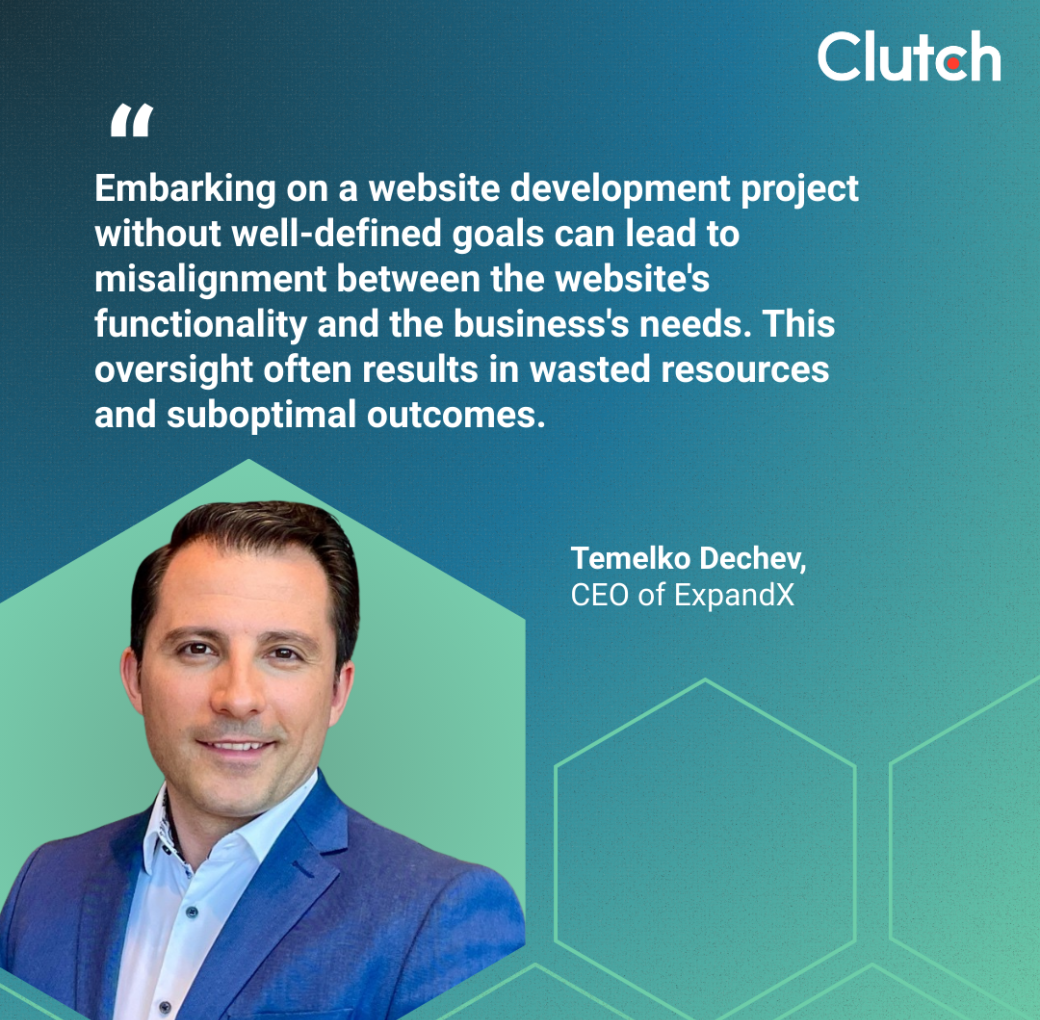A Website That Sells: The Mistakes to Avoid to Turn Traffic Into Deals
What are the key characteristics of a corporate website that doesn’t just inform but engages – and sells?

© ECONOMIC.BG / ExpandX
Тemelko Dechev, Managing Partner, ExpandX Marketing & Web
When a website truly works, you don’t feel like you’re browsing a static brochure – you experience a precisely built system that moves information seamlessly and intuitively according to user needs. Visitors arrive, instantly understand where they are and what to do next, and find content that speaks their language. The path to inquiry or purchase feels short, logical, and natural, while trust builds with every interaction – text, visual, or functional.
When a website doesn’t work, the signs are easy to see: a high bounce rate, low conversions, confusing navigation, slow pages, and inconsistent communication tone. Many businesses overload their sites with unnecessary details yet miss the essential ones. Below, we summarize the most common mistakes companies make when building or managing their corporate websites – and how to fix them.
Strategy First
Every successful web project begins with in-depth analysis. It is always the first and most critical step because it defines which functionalities are truly needed, what structure will be most effective, what content formats will add value, and which audiences the business should reach. Only then should design come into play. This order prevents one of the most common mistakes – creating a beautiful but ineffective website that impresses visually but fails to generate results.
In recent years, artificial intelligence and no-code/low-code platforms have changed the game. They allow websites to be launched quickly, with minimal technical effort and lower initial costs. They are excellent tools for a fast start, testing a concept, or creating a basic web presence.
However, when it comes to larger-scale systems – integrations with ERP or CRM platforms, complex user flows, personalized UX, and higher performance and conversion requirements – templates are no longer enough. These projects demand a professional team that thinks strategically, plans in detail, and builds custom solutions. Only then can a website truly serve the business goals behind it, not just look appealing.
In such cases, technology is no longer a simple presence online – it becomes a competitive advantage. A well-designed and professionally developed website is not merely a digital tool; it is a strategic asset – a platform that increases visibility, facilitates sales, and builds trust over the long term.
Navigation That Leads to Engagement & Sales – Not Exits
Navigation and user experience are the backbone of every website – the structure that determines whether users stay and move forward or get lost and leave forever. When navigation is confusing, overly complicated, or written in corporate jargon instead of human language, the site stops guiding and starts frustrating. Studies show that nearly half of all users abandon websites with poor navigation, while mobile experience optimization can reduce bounce rates by up to 30%. These aren’t just statistics – they represent real revenue gained or lost.
Effective navigation is designed around user intent and customer journey stages, not the company’s internal hierarchy. The most important pages must be accessible within a single click, without forcing visitors to dig through submenus and redundant links. Menus should be concise, intuitive, and written in natural, human language that guides the user effortlessly.
Behavioral data is the best adviser here. Analytics tools such as Google Analytics 4, heatmaps, and session recordings reveal how visitors actually move through the site – which areas grab attention, where they hesitate, and at what point they leave. These insights are invaluable for optimizing site architecture and content layout.
It is equally important to adopt a mobile-first mindset. Over 60% of all web traffic today comes from mobile devices, and for many industries, this share exceeds 70%. The old approach – “desktop first, mobile later” – is obsolete. Users expect the same convenience, speed, and clarity on every screen. A website that doesn’t look and function perfectly across phone, tablet, and computer loses its core purpose – to guide the customer confidently toward action.
When navigation is intuitive, mobile experience seamless, and content easily accessible within a few clicks, the website stops being a digital brochure and becomes a true sales and trust engine. That’s the difference between simply being online and making an actual digital impact.

First Impressions Matter: Design, Trust, and Conversion Boosters
A high bounce rate is rarely accidental. It usually signals three core issues: outdated design, confusing structure, or lack of trust. In today’s fast-paced digital world, users judge a website in seconds. Studies show that 83% of visitors form an opinion about a site’s credibility in less than 20 seconds, while 84% say that design directly influences their purchase decision. In other words, design is not just aesthetics – it’s business-critical.
A good website inspires confidence immediately. It doesn’t need time to persuade; it communicates clearly, consistently, and professionally from the first glance. Regular visual refreshes every one to two years maintain a sense of modernity, while a full redesign every three to five years ensures alignment with current UX standards and user expectations. This rhythm is not vanity – it’s survival in a fast-evolving digital landscape.
Consistency in visual identity and communication tone is just as essential. Colors, typography, spacing, and layout should feel like parts of a single coherent system, not a collage of separate projects. A website is the digital face of a brand – and every inconsistency undermines its authority and credibility.
Equally important are trust signals – small details that shape perception subconsciously: a valid SSL certificate, visible contact details, transparent company information, client reviews, partner logos, and awards. These elements function as visual arguments that reassure the visitor they’re dealing with a real, professional business.
The truth is that users rarely “read” your website – they scan it. Their eyes search for visual hierarchy, orientation, and confirmation they’ve come to the right place. The faster they find these signals, the more likely they are to stay, engage, and ultimately become customers.
Speed Is Everything
A slow website is like a store with a beautiful window display but a locked door. Half of all users wait no more than 10 seconds before leaving. The reasons are almost always technical: large images, too many plugins, or uncompressed resources.
Optimization is not optional – it’s digital hygiene. Compress images, use a CDN, implement lazy loading, check your performance through PageSpeed Insights and Core Web Vitals, and remove unnecessary plugins and scripts. True speed doesn’t come from add-ons; it comes from a clean backend, disciplined development, and a culture of constant improvement.
Content Pillars and Communication Strategy: Promotions Are Just the Tip of the Pyramid
A website that sells consistently doesn’t behave like a store in permanent sale mode. The real power of digital marketing lies not in constant discounts, but in consistent, value-driven communication that builds trust and authority. A strong strategy is built upon clearly defined communication cores and content pillars – topics that showcase a company’s expertise, present real client success stories, solve problems, and deliver educational value through guides and insights.
These elements form the foundation of an online brand – making it recognizable, reliable, and useful. Promotional campaigns, while important, should make up no more than 10–15% of the annual communication calendar. The remaining focus should be on valuable, authentic content that educates, engages, and inspires.
This type of communication builds trust – and trust sells far better than discounts ever could. It transforms a brand from a source of offers into a source of knowledge. When audiences see consistency, professionalism, and authenticity, they begin to associate the brand with credibility and naturally choose it, even in competitive markets.
The outcome is tangible: sustainable traffic, lower acquisition costs, and higher conversion rates. Marketing stops being an expense and becomes an investment – a system that compounds over time and drives steady business growth.
SEO and Organic Presence: A Digital Network That Works for You
Paid advertising is an excellent accelerator – it delivers immediate results but disappears as soon as the budget dries up. SEO and organic content, on the other hand, build digital equity that grows with time and continues to work even during quiet periods. This is the difference between a temporary boost and long-term presence.
Modern search engines and AI-powered algorithms now reward not isolated pieces of content, but entire ecosystems – websites where articles, videos, and visuals are connected by a unified logic, tone, and identity. The more consistent this ecosystem, the stronger the brand’s “digital gravity field” – the invisible force that attracts audiences naturally.
Each new page or video reinforces the rest, contributing to a coherent narrative. Over time, the website becomes an authoritative source of information and trust – a destination users and algorithms return to again and again. That’s the strength of organic growth: it doesn’t rely on budget; it grows through value.
From Web Traffic to Deals
In the digital world, trust can be lost over the smallest details. A typo, a broken link, a missing image, or an outdated page can instantly undermine months of marketing effort. Users rarely see such mistakes as accidents – they read them as signs of carelessness. That’s why regular technical and content audits are essential. Good digital hygiene is invisible when present, but immediately noticeable when absent.
Aggressive pop-ups, autoplay elements, or excessive prompts for action can be equally damaging. Though designed to increase conversions, they often irritate users, reduce trust, and lead to early exits. Effective interactions must be timely, measured, and genuinely useful. If an element doesn’t provide value – information, offer, or invitation – it shouldn’t be there. Modern users seek partnership, not pressure.
Measuring success also requires realism. There’s no universal “good” bounce rate – it depends on the industry, audience, and page type. E-commerce sites typically have lower bounce rates than blogs or landing pages, which naturally have shorter sessions. What matters most is the trend: whether performance is improving over time and whether conversion-critical pages perform better. Data matters only when used for improvement, not for vanity.
Website optimization should never be reduced to technical maintenance. It’s a continuous process of analysis, observation, and adaptation – a balance of marketing logic, UX thinking, and business pragmatism. An effective website is not a static catalog but a living system that evolves with the company and the market. It requires ongoing care – from content updates and design refreshes to feedback and new technologies.
When all these elements – technical stability, thoughtful content, well-timed interactions, and realistic performance metrics – work together, a website transforms from a digital brochure into a business asset. Traffic stops being a stream of clicks and becomes a stream of opportunities. This is the essence of digital success: not chasing attention, but creating experiences that hold it, inspire it, and convert it into results.

How to Improve Your Website
Optimizing and properly structuring your corporate website transforms a company’s online presence from a static brochure into a strategic engine for growth and conversions, shares Temelko Dechev, Managing Partner at ExpandX Marketing & Web. When structure is logical, content is relevant and inspiring, and user experience is seamless, the website starts to sell instead of just to inform. Then online channels stop competing with each other and begin to work in synergy – attracting the right audience and turning traffic into real business results. This isn’t about luck or trends but about consistency, strategic planning, UX discipline, and quality content that builds trust.
At ExpandX Marketing & Web, we see every day how well-designed websites become growth engines for companies across industries and continents. Our approach combines strategy, technology, and creativity into a unified ecosystem that delivers predictable, measurable, and sustainable results. We create websites that not only look good but function as high-performing marketing machines – attracting qualified users, driving engagement, and boosting conversions.
Our clients across Europe, the United States, Canada, and the Middle East report tangible results: more qualified inquiries, stronger online visibility, higher return on investment, and steady expansion into new markets.
These and other essential insights about digital assets and web development will also be central topics at the upcoming MastersCONF 2025 – one of the leading business, technology, and marketing conferences in the region. As a co-organizer, the ExpandX team will provide participants with a free analysis of their company website, offering clear data and actionable insights on what may be preventing their business from scaling effectively.
MastersCONF 2025 brings together hundreds of entrepreneurs, business owners, executives, and marketing leaders who share experience, explore trends, and leave with concrete strategies for growth. If you want to see real-world business cases and witness firsthand the thinking that powers ExpandX’s results across Europe, North America, and the Middle East – MastersCONF 2025 is the place to be.

 *
* 


